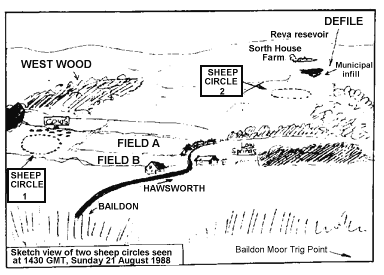 |
Science Frontiers ONLINE No. 64: Jul-Aug 1989 |
|
|
Sheep circles!
Britain has been plagued lately with circular areas incised in fields of cereal crops. G.T. Meaden has collected scores of such events, some of which he has published in his Journal of Meteorology. On the theory that one kind of circle might somehow be related to another kind of circle (the same reasoning biologists employ to draw the Tree of Life), J.C. Belcher submitted a most interesting letter to Meaden.
"By their very nature sheep tend to be stubborn self-willed animals exhibiting individual characteristics not suggestive of good group co-ordination. For example, when disturbed by a potential predator, a flock of sheep tends to mass protectively in a group of irregular outline, the group being formed of individual groups of small numbers of sheep. When grazing undisturbed, sheep tend to fan out from a given point, sometimes following a dominant group leader. Progress is usually uncoordinated and ragged. In general, patterns presented by sheep en masse are seen to be haphazard, indeed, generally random in nature. If follows that any suggestion of flocks of sheep forming geometric patterns would appear to be highly improbable, since this would call for group coordination only to be found in such as wolves and wild-dogs. In view of this it would appear that certain exceptional observations made on Sunday 21 August 1988 would be worthy of recording.
"Out on an afternoon drive M. Belcher parked his car near the trigonometric survey point on Baildon Moor, near Leeds, in Yorkshire, at approximately 1430 GMT facing northeast. His wife suddenly exclaimed: 'Look at that circle of sheep in that field!' That was Sheep Circle 1 on the plan where 'a hundred or so sheep were in a circular formation, each sheep being more or less equidistant from the next. At the north end of the field some 20 or 30 cows were standing, grazing and chewing cud in the usual haphazard manner. The circular formation of these sheep was so unusual that I thought I was looking at bales of hay set out in the field by the farmer. Indeed, a stoneage stone circle might have been appropriate on this occasion. I looked around from north-west to north-east, and then espied a similar sheep circle (2) on a plateau opposite...In the sector between north and north-east, flocks of sheep were in other fields but in no case exhibited the circular formation, being in typically haphazard groups.' In a second letter Mr Belcher emphasized that the sheep of the two circles were 'variously standing, laying down, or grazing. All quietly occupied, but nevertheless forming this very regular circular formation."
(Meaden, G.T.; "Sheep in Circular Flocks: Is There a Meteorological, or Some Other, Connection?" Journal of Meteorology, 14:54, 1989. Journal address: 54 Frome Road, Bradford-on-Avon, Wiltshire, ENGLAND BA15 1LD.)
Comment. In his letter, Belcher wondered what mysterious force had arrayed the two flocks of sheep so neatly. Meaden, very timidly to be sure, ventured that the same sort of whirlwinds that he believes cuts the crop circles might cause sheep to drift outwards into a circle! In the interest of complete-ness, some grazing animals, such as the muskoxen, will form into a circle when threatened. But are there appropriate whirlwinds in the Arctic? So much for deprecating taxonomy-through-morphology!

|